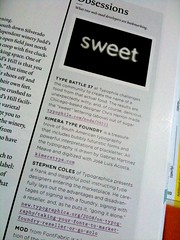
- Image by Stewf via Flickr
Anyone can have a Facebook page, but not everyone gets into the newspaper. Any editor can keep doing what they’ve always done, but not many feel the need to bridge their abilities into a new and uncertain realm. Any media company can make a Web site, but not every media company has properties so hot that they don’t need to fight it out in the digital space.
These messages surfaced recently in different online (of course) essays, and all point to a current, lingering, and somewhat illogical status advantage held by traditional media.
The first article, written by Michael Koretzky, a judge of a college journalism competition for the Society of Professional Journalists (SPJ), was published in the Huffington Post. Koretzky notes that for college journalists, being published in print is still a big deal. He thinks the printed page is akin to the velvet rope:
The easiest way to insult a college journalist? Tell him his story will run as an “online exclusive.” Since websites have an infinite amount of space that costs nothing, and since newsprint has a limited amount of space that costs a lot, and since all print stories run online anyway, college journalists interpret “online exclusive” as “you think I suck.”
As print editions shrink with the recession, that real estate only becomes more valuable. It reminds me of the way college students decide which nightclubs to go to. What’s the most popular nightclub in a college town? The one you can’t get into because there’s a velvet rope and a line out the door.
The scarcity of print in today’s world, especially when contrasted with the abundance of online, makes print publication something to strive for. It motivates college journalists in ways that online publication — which feels both accessible and pedestrian — does not.
Ultimately, however, the appeal hinges on vanity and ego. As Koretzky notes, despite plenty of outlets for print at his campus, most students don’t read the print. But for the authors/student-journalists? The thrill of showing off a byline or headline they wrote — and that it was printed — beats all. It’s pure ego fulfillment, validation that they deserve to be on the other side of the velvet rope of scarcity.
We’ve all encountered this kind of superficiality before, perhaps even indulged in it. Print’s illusions are legion — authors secretly cling to the belief that every copy printed is read, that lack of feedback equals not only awareness but adulation, and that the glow they feel leafing through their print edition is shared broadly and simultaneously.
Editors and authors are susceptible to these feelings, and often draw on them to argue for the effectiveness of print — despite evidence that issues sit for weeks or months before being picked up, if they are perused at all; despite evidence that “reading” is really “skimming” in the majority of cases; and despite evidence that readers are moving to a “print=disposable/web=archive” mode of information management, one that is reducing time spent with print and increasing time spent online.
Digital publishing’s strong metrics banish the illusions of print, and that can be wrenching. It’s painful at times to see how infrequently some excellent materials are actually accessed, despite being indexed in major services, emailed to tens of thousands of people, and even published in print. Only later does the good news come — the long-tails emerge as the archival utility accumulates.
But the superficial, immediate thrill of print is hard to compete with.
Aside from not allowing that “brand” rather than print may be the power behind the college newspapers in question (after all, college newspapers do have a wonderful nursery — a campus — in which to cultivate a brand), it also occurs to me that perhaps Koretzky and his ilk could be doing a better job teaching journalists about online publishing — how to use actual metrics vs. speculative metrics; search engine optimization; social media propagation; blogging; reaching the larger world beyond the school more effectively; syndication and information brokering. He even admits that his school newspaper’s site is a mess. So part of the problem may be that print is more attractive because . . . well, because these college journalism programs are doing digital so badly.
So, here we have universities perpetuating a gap in online publishing expertise and editorship — a gap possibly based on conflating print with elitism. Another recent post touches on how the current job market is still rewarding this kind of print:function conservatism. Entitled “Real Editors Ship,” the post details the role of editors in coordinating and cultivating huge, complex, edited programming solutions on a daily basis. The problem is that editors are attached to the media they’re familiar with — radio editors at NPR want to continue to edit for radio; editors weaned on print persist in print habits. Few are crossing into the relatively unknown territory of doing their magic for a digital property.
Yet, aside from being important to long-term career success, editorial work in the networked world may be vital to solving our much talked-about “filter failure” problem. The author observes that “[t]he Semantic Web is basically the edited web, for some very nerdy take on editing. Which implies editors,” and then argues that this layer of filtering, shaping, and contextualizing is what will keep the Web useful. However, he also notes three problems that stand in the way:
- Editors and journalists are mostly Luddites, and they don’t really hang out in places where technology-oriented media companies might think to hire them.
- Most editors want to be editing for print or broadcast, not for the Web, which is still seen as slumming it.
- Big organizations, even if they now have content problems, won’t hire editors, or enough editors, to manage their content.
Some content companies aren’t even trying. A recent article in the Economist touches on what they call “analogue holdouts” (you get more vowels with British English — or is that English English?). These are media entities that have stayed firmly in the analog world — the Beatles, Harry Potter, and the crew of “The Deadliest Catch.”
As the article explains (and forgive me if I think the reporter inadvertently echoes the setup for a probable Economist strategy meeting):
They have some good reasons. Online advertising is worth much less than television or print advertising. It is hard to persuade people to pay much (if anything) for digital content. Technology firms such as Amazon and Apple can often set retail prices. Digital products can be less beautiful than physical ones.
However, there are a few common themes to these holdouts — first, none lacks brand awareness; second, not one has a loss-leader mentality (the Beatles no longer tour, so don’t need to sell songs to drive concert attendance; Harry Potter’s contracts are signed, sealed, and delivered); and third, despite not putting all their content online, they are most certainly online properties, because that’s where their audience talks about them (the Beatles have 5.6 million fans on Facebook, Harry Potter 2.9 million).
It turns out that theft is one potential driver for moving these holdouts online. Right now, with little at stake online, digital piracy is rampant, especially for the Hogwarts crowd. Once these entities move online, their caretakers will naturally work to intervene to end piracy or work their commercial presence in such a way that it makes piracy unnecessary or unsatisfying. Participation is its own protection.
As Clay Shirky has said, publishing is the new literacy — it’s available to anyone and everyone with Internet access. The “Publish” button makes publishing no longer scarce. Knowing how to publish is now akin to knowing how to read — a basic skill, no longer locked away inside the vault of professional scarcity.
And perhaps that makes it no longer as aspirational.
We’re familiar with the scarcity of print. It’s expensive and becoming scarcer every year — hence, being published in print is a status symbol, making a very rough but tangible cut that appeals to the senses, including the sense of elitism.
However, as audiences continue to move online, print will likely continue this drift into the symbolic and status realm. Someday, print may convey only status, leaving real communication to the technologies that work. Whether the writers, editors, and publishers migrate early enough and in sufficient numbers to make a difference remains to be seen.
Discussion
8 Thoughts on "Is Print an Elite Medium? Or a Medium for Elitists?"
By your own argument print must be more selective, hence of higher quality. There is nothing elitist in this. Moreover, an editor has two primary jobs — selection and improvement of articles. This is just as true for on-line content as for print.
Ah, so scarcity = quality? I don’t believe it, and my coverage of these articles doesn’t argue for it. For instance, there are many examples wherein abundance = quality. Think of all the literacy uncorked when printing became commonplace. Oh, sorry, I’m sure the world was better before printing, when hand-copying made copies scarce, so the only thing copied was church orthodoxy. How I yearn for the cultural implications of that kind of quality scarcity!
Print is selective because of scarcity (or, put another way, because it’s expensive to use and deliver). Dealing with this kind of scarcity can lead to many behaviors, including running articles that are too brief, editors who spend too much time “playing to the crowd” (printing the same coverage in an LA paper as in a NY paper because delivery is difficult), and materials that are thinned of important dimensions (data sets reduced to 2D illustrations) because of the limited functionality and scarcity of print. Scarcity means selection, and this selection is not always driven by quality, and it doesn’t always achieve quality. In fact, most often these days, print has the same content as the online version but with inferior distribution abilities. So, the scarcity of print actually inhibits online quality because we don’t write for online’s abundance.
Also, let’s not forget that print, in many, many instances, is only as large or long as the advertising budget allows. So, as scarcity of advertising has increased, print space has decreased. There’s not much pure about that kind of bargain.
My point was that print scarcity equating to quality is a familiar (wrong, but familiar) correlation. However, print’s perceived superiority is being driven more now by ego and vanity rather than effectiveness.
Glad to see you mentioned advertising. For most science journals, that’s what’s driving the continuing existence of print editions. There’s no elitism there, as the print and online versions contain the same content (save the electronic-only sorts of data like movies and such) and the pdf is the format of choice for the reader. But advertisers continue to stubbornly place value on print ads and little value on online ads, so one can hardly blame publishers for continuing to accept this revenue stream as long as it lasts.
Another reason to keep print around: the National Library of Medicine has different rules for PubMed acceptance for print journals versus online-only journals. If you’re online-only, then you must archive all your articles somewhere like PubMed Central in order to get into PubMed. Many publishers prefer to keep control over access of their back issues, rather than ceding to the NLM’s rules and I know of several who keep their journals in print editions just to get around this regulation.
Sir:
Winfred, my manservant, just handed me a print-out of your “blog” pamphlet. Ordinarily I spend the morning pursuing the news of the republic in the Gray Lady before taking the hounds out for a constitutional. However, I feel that I must detour from my morning routine to offer a corrective to your broadsheet.
Firstly, I would like to object to the notion that university students should be writing newspaper columns at all. Those hippies should be delivering newspapers, not writing them.
Secondly, if there is any possibility that those mop headed yodelers might tour again, we must restart the volcano in Iceland immediately to forestall their transatlantic crossing.
Thirdly, I think we are experiencing a case of signal-lag. Quality signals take time to develop. We have learned over the course of decades that publication in certain venerable papers and journals is a signal of quality. Those papers and journals are, in turn, venerable because they have published many good articles/papers over the decades. And so it goes. When there is a tectonic shift, however, the signals are still describing the old landscape and take time to reorient themselves. What is puzzling about Professor Koretzky comment is that even the lagging signals do not distinguish between print and online. While obviously a student journalist would prefer to be published in the New York Times or the Washington Post as opposed to some beatnik’s pamphlet page, no quality signals I am aware of differentiate between whether an article appears in good old fashioned newsprint or via some godforsaken Babbage machine. An article in the Gray Lady is an article in the Gray Lady regardless of what format it is printed on.
I have now delayed my constitutional long enough. After I am done walking the hounds I must check in on the factory – buggy whips do not make themselves!
Dear Squire Clarke,
Thank you for deigning to scribble a few lines of thoughtful prose during what appears to have been a nearly frantic morning of duties and responsibilities. I know how the pressing issues of capitalism combine with the unrelenting tasks of running a large estate with servants underfoot. It’s a miracle we get our pipes smoked at all!
After contemplating your most salient points, I cannot help but heartily agree with you once more, just as I did that night at the Ritz. You’ll recall the laugh we shared razzing our host over his belief that this newfangled eye-patch or eye-pad would amount to a hill of beans. Who wants to wear an eye-patch, much less an eye-pad? We and the King’s navy spent far too much in blood and treasure driving pirates from our shipping lanes to make merry with such language! He deserved the harsh upbraiding we delivered. Your last repartee was particularly piercing. I remember I almost spilt my sherry in merriment.
I’m off to run my typewriter factory. There seems to be no end to demand for these clever contraptions! My grandson will certainly enjoy handing over my typewriter empire to his own grandchildren someday.
Tally-ho!



